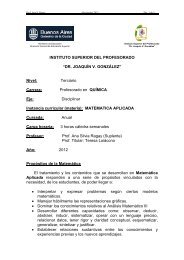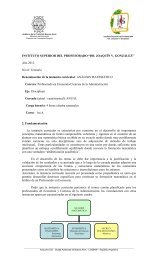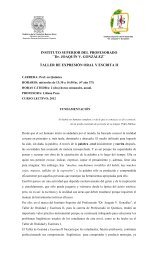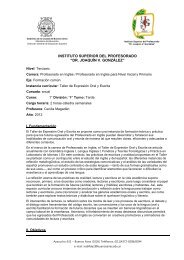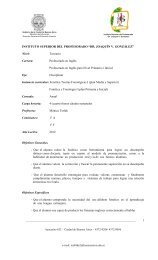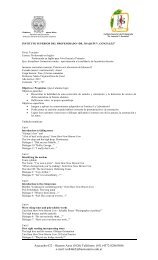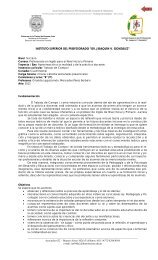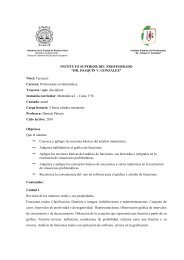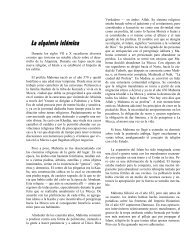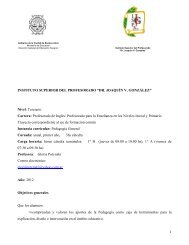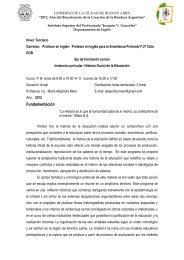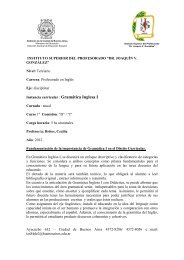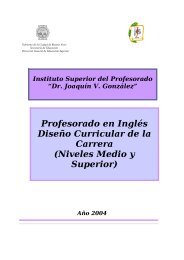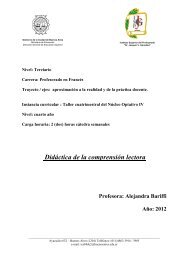Los retos de la historia oral en el siglo XXI: diversidades ...
Los retos de la historia oral en el siglo XXI: diversidades ...
Los retos de la historia oral en el siglo XXI: diversidades ...
Create successful ePaper yourself
Turn your PDF publications into a flip-book with our unique Google optimized e-Paper software.
Sesiones parale<strong>la</strong>s / Parall<strong>el</strong> sessionsSOUZA, Carlos Roberto Pereira <strong>de</strong>Las voces <strong>de</strong>l proyecto <strong>de</strong> integración educativa losestudiantes social - Peis, Campinas - São Paulo - Brasil,2005 – 2010Este trabajo tuvo como objetivo reconstruir <strong>la</strong> trayectoria educacional <strong>de</strong> loseducandos <strong>de</strong>l Proyecto Educativo <strong>de</strong> Integración Social – PEIS. La pesquisainvestigo los educandos que frecu<strong>en</strong>taban <strong>el</strong> curso superior y que, al mismotiempo, continuaban a frecu<strong>en</strong>tar <strong>el</strong> PEIS. Para eso, recurrimos a <strong>la</strong> Metodología<strong>de</strong> <strong>la</strong> Historia Oral, método cualitativo fundam<strong>en</strong>tado <strong>en</strong> los testémonos <strong>de</strong> loseducandos <strong>en</strong>vu<strong>el</strong>tos, pues esa metodología ti<strong>en</strong>e como lema “dar voces a losactores sociales <strong>en</strong>vu<strong>el</strong>tos <strong>en</strong> <strong>la</strong> investigación”. La disertación se conc<strong>en</strong>tra <strong>en</strong>dos ejes <strong>de</strong> reflexión: <strong>el</strong> primero objetiva compr<strong>en</strong><strong>de</strong>r <strong>el</strong> pasado reci<strong>en</strong>te, a manut<strong>en</strong>ciónda longevidad <strong>de</strong>l Proyecto y su pap<strong>el</strong> socio-político y pedagógico; y<strong>el</strong> segundo eje se refiere a <strong>la</strong> pesquisa, al int<strong>en</strong>tarmos compr<strong>en</strong><strong>de</strong>r <strong>la</strong>s oríg<strong>en</strong>es(regionales, sociales, educacionales), <strong>la</strong> trayectoria educacional <strong>de</strong> los educandos<strong>de</strong>l PEIS y <strong>la</strong>s contribuciones <strong>de</strong> <strong>la</strong>s prácticas pedagógicas <strong>de</strong>l Proyecto <strong>en</strong>sus vidas y activida<strong>de</strong>s profesionales. A través <strong>de</strong> <strong>la</strong> Metodología <strong>de</strong> <strong>la</strong> HistoriaOral, este trabajo consiguió <strong>de</strong>scribir <strong>la</strong> trayectoria educacional <strong>de</strong> los educandosque retornaron al PEIS mismo <strong>de</strong>spués <strong>de</strong> alcanzar<strong>en</strong> <strong>la</strong> <strong>en</strong>señanza superior,re<strong>la</strong>cionando sus hab<strong>la</strong>s con <strong>la</strong>s prácticas pedagógicas <strong>de</strong>l Proyecto.This work pres<strong>en</strong>ts a reconstruction of stu<strong>de</strong>nts’ trajectory of EducationalProject for Social Integration - PEIS. The research investigated the stu<strong>de</strong>ntswere <strong>en</strong>rolled in a university course and continued to att<strong>en</strong>d the PEIS. To this<strong>en</strong>d, we chose Oral History Methodology, a qualitative method based on testimoniesof the stu<strong>de</strong>nts involved. This methodology has as a motto: “givingvoice to the social actors involved in research”. This work focuses on two axesof reflection: first, the compression of the rec<strong>en</strong>t past, the maint<strong>en</strong>ance andthe role socio-political and educational of the Educational Project for SocialIntegration. Second, the research to un<strong>de</strong>rstand the origins (regional, social,educational), the educational trajectory of the PEIS stu<strong>de</strong>nts and the contributionsof the teaching practices in their lives and professional activities. ThroughOral History Methodology, this work was able to <strong>de</strong>scribe the trajectory of educationof the stu<strong>de</strong>nts who returned to PEIS ev<strong>en</strong> after they reach a universitycourse, re<strong>la</strong>ting their speeches with the teaching practices used in PEIS.——————————————————————————————————————————————C<strong>en</strong>tro Cultural <strong>de</strong> <strong>la</strong> Cooperación——————————————————————————————————————————————Subtema / Subteme 3Salud e <strong>historia</strong> <strong>oral</strong> / Health Oral HistorySa<strong>la</strong> Héctor P. Agosti - Mesa / Session 38Coordinan / Chair: C<strong>el</strong>ia Sipes——————————————————————————————————————————————GODOY CATALAN, Lor<strong>en</strong>a y ZARATE, María SoledadLas Madres <strong>de</strong>l Programa <strong>de</strong> Salud Materno Infantil:<strong>la</strong> visión <strong>de</strong> matronas. Chile, 1952-1973Consi<strong>de</strong>rando algunos antece<strong>de</strong>ntes, <strong>el</strong> año 2010 se inició un estudio que se<strong>en</strong>cu<strong>en</strong>tra <strong>en</strong> <strong>de</strong>sarrollo, que se propuso <strong>de</strong>scribir y analizar <strong>el</strong> <strong>de</strong>sarrollo <strong>de</strong>lPSMI <strong>en</strong> <strong>la</strong> ciudad <strong>de</strong> Santiago, <strong>en</strong> <strong>el</strong> marco <strong>de</strong> <strong>la</strong> creación <strong>de</strong>l SNS <strong>el</strong> año 1952,hasta <strong>el</strong> año 1973. Una <strong>de</strong> <strong>la</strong>s hipótesis p<strong>la</strong>nteadas fue que dicho programa habría<strong>de</strong>sempeñado un pap<strong>el</strong> estratégico <strong>en</strong> <strong>la</strong> implem<strong>en</strong>tación y consolidación<strong>de</strong>l SNS, lo que evi<strong>de</strong>nciaría <strong>la</strong> influ<strong>en</strong>cia histórica que tuvieron <strong>la</strong>s políticas <strong>de</strong>protección a <strong>la</strong> maternidad y <strong>la</strong> infancia <strong>en</strong> <strong>la</strong> mo<strong>de</strong>rnización <strong>de</strong> <strong>la</strong>s políticassanitarias <strong>en</strong> Chile, durante <strong>el</strong> periodo estudiado.Para realizar este estudio, junto a <strong>la</strong> revisión un ext<strong>en</strong>so y clásico repertorio <strong>de</strong>fu<strong>en</strong>tes docum<strong>en</strong>tales (archivos, monografías, tesis, publicaciones periódicas) ybibliográficas, se incluyó <strong>el</strong> uso <strong>de</strong> fu<strong>en</strong>tes <strong>oral</strong>es lo que constituye prácticam<strong>en</strong>teuna propuesta inédita. Específicam<strong>en</strong>te se trata <strong>de</strong> <strong>la</strong> inclusión <strong>de</strong> <strong>en</strong>trevistas individualesa profesionales <strong>de</strong> <strong>la</strong> salud que tuvieron una participación directa <strong>en</strong> <strong>el</strong> diseñoe implem<strong>en</strong>tación <strong>de</strong>l programa <strong>de</strong> salud materno infantil, médicos, matronas y<strong>en</strong>fermeras; y <strong>en</strong>trevistas a madres que tuvieron a sus hijos <strong>en</strong> <strong>el</strong> periodo seña<strong>la</strong>do yque fueron at<strong>en</strong>didas <strong>en</strong> establecimi<strong>en</strong>tos públicos (hospitales y consultorios).SINKINESH, Atale Gebere“Unread Stories in the Archives With Special Refer<strong>en</strong>ceto two leprosy Sufferers. A Study in Oral History”Oral History is primarily concerned with the study of social, economic, cultura<strong>la</strong>nd political ev<strong>en</strong>ts in the past. It is concerned with all sectors of society includingthe literate and uneducated, the wealthy and the poor, the advantagedand the marginalized. The main objective of this study is to explore the life historyof people who have be<strong>en</strong> marginalized because of leprosy that they havebe<strong>en</strong> living with. The data for the study was collected from two informantss<strong>el</strong>ected by means of purposive sampling. The informants have lived acrossthree major regimes in Ethiopia- the rein of Emperor Hailes<strong>el</strong><strong>la</strong>sie, the MilitrayDerg era and the era of incumb<strong>en</strong>t EPRDF Governm<strong>en</strong>t. It is assumed that thecollected data that covers these periods would be compreh<strong>en</strong>sive <strong>en</strong>ough tomake comparisons. The data was collected by means of interview which wasrecor<strong>de</strong>d and transcribed. The cons<strong>en</strong>t of the informants for the interview andfor photographs was obtained. There stories about their lives and the stigmatizationplights they <strong>en</strong>countered across these regimes have be<strong>en</strong> docum<strong>en</strong>ted.The findings show that their life was re<strong>la</strong>tiv<strong>el</strong>y better during EmperorHailes<strong>el</strong><strong>la</strong>sie’s era than it was during the subsequ<strong>en</strong>t two eras. This was attributedto the low cost of living at the time and to the willingness of the societyto ext<strong>en</strong>d its support in the forms of donations to these people. They reportedthat ev<strong>en</strong> the king who used to visit them occasionally was paying att<strong>en</strong>tion tothem. On the other hand, the findings from the study revealed that during theregimes of the following two governm<strong>en</strong>ts, the society was not willing to donatebecause of the high cost of living that they had be<strong>en</strong> experi<strong>en</strong>cing. The studyalso revealed that victims of leprosy were sometimes thrown into jails becauseon the pretexts that they were idle and dangerous to street security. G<strong>en</strong>erally,the study indicated that life during the <strong>la</strong>st two governm<strong>en</strong>ts was difficult forvictims of leprosy. In addition to the economic problem they were facing, theirhuman and <strong>de</strong>mocratic rights were also abused, as the study indicated. Theirstories also revealed that the stigmatization problem that they were experi<strong>en</strong>cinghas now eased and ev<strong>en</strong> shifted to HIV/ AIDS pati<strong>en</strong>ts; and this has createdan opportunity for people with leprosy, particu<strong>la</strong>rly for the m<strong>en</strong> to find partners.Female lepers are however still marginalized/stigmatized.Barbosa, Car<strong>la</strong> CristinaTradición e I<strong>de</strong>ntidad: Historia Oral <strong>de</strong> curan<strong>de</strong>rosSe discute <strong>en</strong> este docum<strong>en</strong>to, <strong>la</strong> tradición <strong>de</strong> curan<strong>de</strong>ros <strong>en</strong> <strong>el</strong> conocimi<strong>en</strong>to<strong>de</strong> hombres y mujeres- que <strong>en</strong> sus activida<strong>de</strong>s diarias adquirir conocimi<strong>en</strong>tos<strong>de</strong> una tradición <strong>de</strong> uso <strong>de</strong> <strong>la</strong>s p<strong>la</strong>ntas. Así, <strong>el</strong> estudio se c<strong>en</strong>tra <strong>en</strong> <strong>la</strong> anotación<strong>de</strong> los conocimi<strong>en</strong>tos tradicionales <strong>de</strong> los curan<strong>de</strong>ros a través <strong>de</strong> <strong>la</strong> <strong>historia</strong><strong>oral</strong>. La <strong>en</strong>cuesta se llevó a cabo <strong>en</strong> <strong>la</strong>s ferias y mercados <strong>en</strong> <strong>el</strong> norte <strong>de</strong> MinasGerais, a partir <strong>de</strong> <strong>en</strong>trevistas con los curan<strong>de</strong>ros que trabajan <strong>en</strong> estos espacios.En este trabajo, <strong>el</strong> arte <strong>de</strong> curar los curan<strong>de</strong>ros se ha investigado con <strong>el</strong>fin <strong>de</strong> <strong>en</strong>t<strong>en</strong><strong>de</strong>r cómo dar a estos conocimi<strong>en</strong>tos popu<strong>la</strong>res y <strong>la</strong> tradición. Por lotanto, <strong>el</strong> curador es consi<strong>de</strong>rado aquí como t<strong>en</strong>er conocimi<strong>en</strong>tos transmitidos<strong>de</strong> g<strong>en</strong>eración <strong>en</strong> g<strong>en</strong>eración. Este conocimi<strong>en</strong>to es una tradición <strong>de</strong> <strong>la</strong> pob<strong>la</strong>ción<strong>de</strong>l Norte <strong>de</strong> Minas Gerais, que utiliza p<strong>la</strong>ntas medicinales para curar sus<strong>en</strong>fermeda<strong>de</strong>s. La <strong>en</strong>cuesta trató <strong>de</strong> reconocer <strong>la</strong> i<strong>de</strong>ntidad <strong>de</strong>l curan<strong>de</strong>ro, <strong>la</strong>división <strong>de</strong> po<strong>de</strong>res se ha establecido y lo que su p<strong>en</strong>sami<strong>en</strong>to. Esto fue a partir<strong>de</strong> un análisis <strong>de</strong> <strong>la</strong> epistemología, que se originó a partir <strong>de</strong> <strong>la</strong> red conceptual<strong>de</strong> <strong>la</strong> <strong>historia</strong> <strong>oral</strong> que se usa <strong>en</strong> <strong>la</strong> investigación, que <strong>de</strong>spués <strong>de</strong> todo no essólo <strong>en</strong> los cu<strong>en</strong>tos. Así, <strong>el</strong> estudio fue construido <strong>de</strong>s<strong>de</strong> <strong>la</strong> perspectiva <strong>de</strong>l conocimi<strong>en</strong>to<strong>de</strong> los hombres y mujeres que adquier<strong>en</strong> sus conocimi<strong>en</strong>tos <strong>en</strong> <strong>la</strong>sactivida<strong>de</strong>s cotidianas, <strong>de</strong> una tradición <strong>oral</strong> <strong>de</strong> uso <strong>de</strong> <strong>la</strong>s p<strong>la</strong>ntas.LARANJEIRO, Catarina y VASCONCELOS, CatarinaImages, Histories and Memories or What Means “BeingFrom Mouraria”This article results from a research about the memories of a neighborhoodnamed Mouraria, in Lisbon, carried out on Grupo Desportivo da Mouraria, anassociation supported by Estado Novo and used as a way of i<strong>de</strong>ological propaganda.Departing from the i<strong>de</strong>a of microhistory of Ginzburg (1989), we analyzedthe rituals and activities promoted by this association in Mouraria, throughthe memories of the people who performed and supported them. Assumingthat photographs have an unique contribution in the maint<strong>en</strong>ance of our memories,we let ours<strong>el</strong>ves be gui<strong>de</strong>d by them on the collection of the life historyof each of the interviewees, through the technique of photo-<strong>el</strong>icitation. Thestories and photographs collected intersect with each other, building the historyof Mouraria, its march and fado singers.BARROS, Lívia <strong>de</strong> M<strong>el</strong>oNarratives and photographs: meanings which composethe being a psychologistThe main objective of the research was to <strong>de</strong>scribe and i<strong>de</strong>ntify the meaningsof being a psychologist were built by two stu<strong>de</strong>nts from their <strong>en</strong>try into graduatecourses at a private university in the city of Aracaju-SE, through the narrativesof aca<strong>de</strong>mic life and photographs. It was conducted three interviews:87



